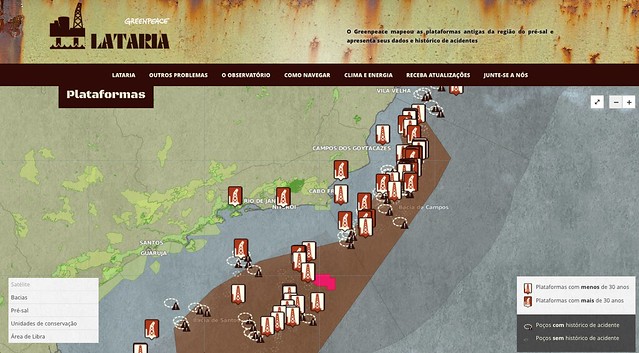Greenpeace’s Lataria: Using Data Visualisation to Monitor the Oil Industry in Brazil
Investigation and data wrangling are a big part of the work of campaigners at Greenpeace offices around the world. Our work in Brazil is no different. Our team here is known for collecting and checking data on the ground about issues such as illegal logging in the Amazon and dodgy nuclear dumps by government agencies.
A new and important area of investigation for Greenpeace is the activities of the growing oil industry of Brazil. In 2007, the state-owned company Petrobras announced the discovery some of the largest submarine reserves of crude oil on the planet. This area which extends for almost 800 km along the Brazilian coast was called “Pré-Sal”, which could be paraphrased as “under the salt” oil, because a thick layer of salt needs to be drilled in order to reach the oil.
This discovery was followed by a great number of offshore concessions made over the last five years. Both national and international companies (most of the time acting together) set immense platforms in the high seas to bring this oil to the surface. As soon as the new cycle of exploration started, the Greenpeace Brazil data and research department decided to find out more about the platforms used by these companies.
Pressured by the demand for oil and the possibilities of reaching large reserves, many companies are now employing second-hand equipment, some of which has been in use for 40 years. In the process of investigating who owns these platforms and who operates them, we ended up finding many records of accidents, ranging from small leaks to the sinking of iron parts into the seas. We found out about some of these accidents via YouTube videos recorded by the workers themselves.
Having compiled a large database of accidents, we started to think how we might present it. Given that we had the location of each platform, we decided that an interactive map that would act as a tracker of these activities would be the right way to show the whole picture. As we are an advocate of transparency, we made the information available for all, either by means of visualisation or by enabling the information to be downloaded from the Greenpeace Brazil database.
The name we chose, “Lataria” (which means more or less “scrap metal”), highlights one of the main conclusions of our analysis: that companies where deploying a lot of old equipment in delicate environments and that they were working under very challenging conditions. The numbers speak for themselves: one third of the platforms are older than 30 years, and 68% of all accidents recorded have happened on these operations.
The technology behind Lataria
The many layers of the map were assembled using MapBox and their map studio software, TileMill. The map layers contain information about accidents and the position of the platforms on the sea. The coordinates for these oil rigs are provided by official sources of information on this issue, publicly available.
The content and map layers were published with the WordPress theme called MapPress developed by Cardume in partnership with InfoAmazonia.
Lataria is continuously being updated with new information released by the government on this matter. Recently, for example, new concessions were made on offshore reserves. So new players, including big multinationals and the state-owned company, are now preparing to drill. The potential for accidents, such as the major leak caused by Chevron in 2011 in Frade’s Field, is high, and the growth of “Pré-Sal” oil extraction activities in the coming years will only increase this risk.
We hope that by combining data visualisation and the power of social media, our website can give voice to the many Greenpeace supporters and pressure companies and government to take the right actions.



Leave a Reply